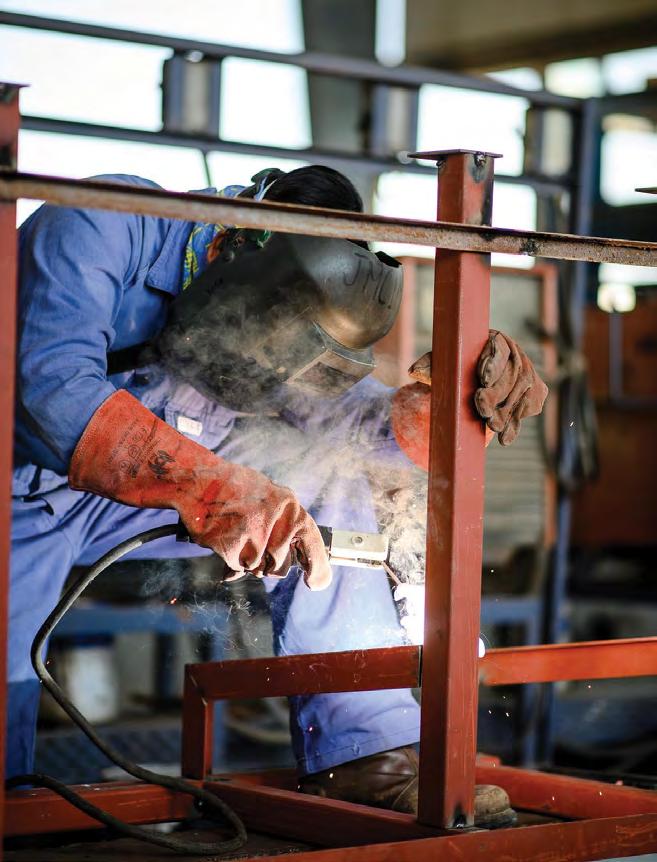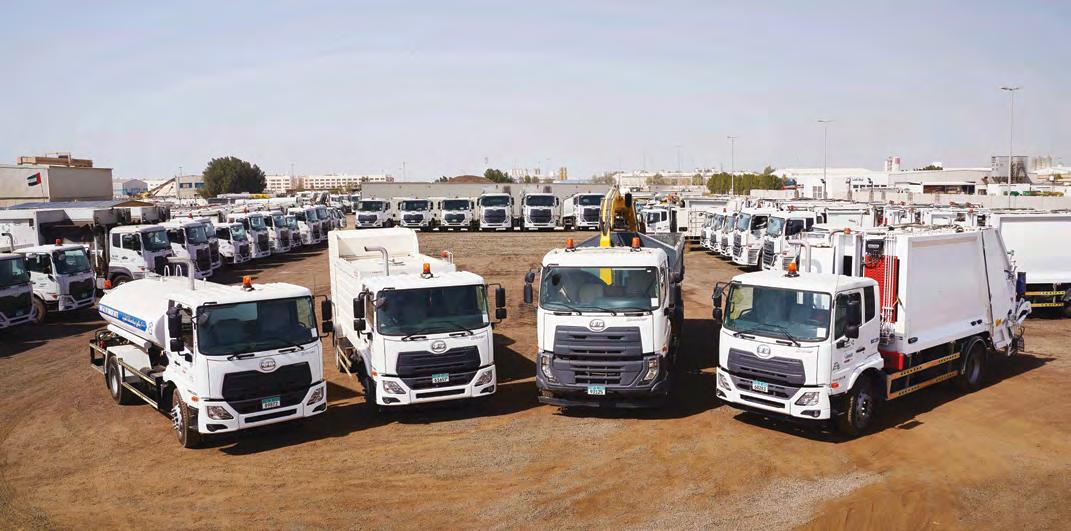
12 minute read
OP-ED
PENNED
Creating stronger bonds in supply chain
Advertisement
Independence is out of the question as reliance on other regions and countries has become a necessity
BY KARIM SHARIFF, PARTNER AT BAIN & COMPANY MIDDLE EAST
COVID-19 threw the global supply chain into a complete frenzy. Many companies were astonished by their own susceptibility. The risk of depending on a supply base that is concentrated in one geographic region has been increasing over the past 30 years, but the pandemic quickly demonstrated how much chaos and pain one unexpected event could inflict.
It was a powerful wake-up call. The disruption triggered by COVID-19 has prompted leadership teams to confront a new era of supply chain volatility.
Flexibility and resilience
Bracing for an era of increased turbulence, leading multinationals are rethinking their supply chain strategies to lower the risk of disruption. In a recent survey of 200 global manufacturers by Bain & Company and the Digital Supply Chain Institute, executives ranked flexibility and resilience as their top supply chain goals. Only 36% of senior executives ranked cost reduction as a top three goal, down from 63% who saw it as a priority over the past three years.
To improve supply chain resilience, 45% of respondents plan to shift production closer to home markets in the coming years. The good news is that automation has reduced the cost of manufacturing, eroding the labour arbitrage advantage that fuelled decades of investment in offshore production. The cost of humanoid robots is comparatively lower now which means companies with processes capable of being automated such as consumer electronics can opt to move supply chains closer to home without raising costs significantly.
Expanding boundaries
For the last 30 years, manufacturing companies have wrung out supply chain costs by disaggregating the various steps of the value chain, concentrating each step with a limited number of companies and geographies to improve economies of scale. As a result, most leadership teams lack sufficient supply chain visibility to assess their geopolitical and geographical risks. Before investing in a new supply chain strategy, successful leadership teams evaluate their supplier and contract manufacturer risk according to two factors: the country where goods are produced and the supplier’s headquarters location.

Two key factors that determine geopolitical supply chain risk are the supplier’s headquarters and its manufacturing location.
Once leaders understand their risk exposure, they start building resilience into their value chains in a two-step process. First, they quickly add flexibility to the supply of finished goods and high-risk subcomponents where possible, to limit immediate risks and satisfy customers. Second, they take a strategic approach to rethinking the value chain from end to end. That includes deciding the pace of change and periodically reviewing decisions based on external conditions and internal capabilities.
Here are three steps that can help companies pioneer the shift to supply chain resilience:
Boost resilience
Supply chain flexibility is becoming an increasingly important concept for gaining competitive advantages. The first priority in making supply chains shockproof is increasing flexibility for supplying finished goods and high-risk subcomponents. This would open the possibility for companies to respond to short term changes in demand and supply situations as well as structural shifts in the environment of the supply chain on an immediate basis.
Not many countries have the capacity and infrastructure to handle all the volume, so manufacturers often have to piece together a solution across multiple neighbouring countries. For many companies, aligning a new production location with demand can deliver significant benefits, particularly in industries where demand is rising even through the downturn, including MedTech and certain consumer products.
Reworking network strategies
For each value chain, leadership teams need to properly balance risk and resilience at the lowest total landed cost. This includes decisions on single vs. multiple sourcing, where to manufacture at each stage of assembly, and proximity to customers. They also need to determine whether to produce in-house or outsource, taking into account variables such as national incentives and declining manufacturing costs. Successful companies revisit their value chain choices regularly, especially in turbulent times.
Balancing cost and risk
Resilience does not eclipse every consideration. As leadership teams start to understand where they need flexibility, they face important trade-offs on cost. Investing in too much flexibility can render a company uncompetitive. As they look to reshape supply chains for the future, successful companies determine how much resilience they need, where it matters most, and what they can afford.
Resilient and flexible supply chains can be a powerful defensive hedge, but also a source of competitive advantage. Leaders make the most of options such as capacity buffers, digital infrastructure and nimble teams to react faster and more efficiently than their peers. The investment to build and maintain these capabilities varies, depending on a company’s need for responsiveness and efficiency, as well as the level of industry competition. This is why the roadmap for resilient supply chains must be linked to a company’s long-term business strategy.
For example, a high-growth business that has high margins and short product life cycles, and is dependent on components coming from widely distributed sources such as high-end cell phones, will require a different type of supply chain resilience than a hypercompetitive lowmargin business, such as clothing or toys, which relies on imported finished goods.
Geopolitical volatility and market turbulence will transform supply chain management in the coming decade. Leadership teams that invest in strategies to increase supply resilience will simultaneously create a new source of competitive advantage.

POWERING FORWARD

BRIAN WOODSIDE
THE GROUP CHIEF FINANCIAL OFFICER AT AL MASAOOD GROUP AIMS TO NOURISH BUSINESS VITALITY BY OPENING DOORS TO NEW IDEAS

AL MASAOOD is one of the leading trading families of Abu Dhabi with a rich diversity of companies and businesses in Abu Dhabi, elsewhere in the UAE and further afield. They were the first company to be registered by the Abu Dhabi Chamber of Commerce. Al Masaood Group has been involved in the commercial development of Abu Dhabi, mirroring the Government’s development path with some key ‘firsts’ such as delivering to the country its first gas turbine and developing the UAE’s first desalination plant.
The Group is celebrating its 50th Anniversary this year and has expansion on its horizon. This is a time where Al Masaood celebrates the legacy and good will it built in its home market, Abu Dhabi and the Western Emirates. The Group will continue to be a pioneer and leverage on its position as one of the country’s more reputable companies that helping to develop and enrich the local economy working closely with both the private and the public sector.

Over the last decade or more, Al Masaood has developed into a highly diversified and dynamic organisation. With a significant market share in the automotive sector, Al Masaood’s diversified portfolio also includes substantial interests in many other sectors including engineering, power, oil and gas, property and retail.
Logistics News ME sat down with Brian Woodside, Group Chief Financial Officer of Al Masaood Group, to discuss his overall role and how the internal logistics for Al Masaood will play a key role in the company’s ambitious plans to expand and diversify.
Brian Woodside joined the Al Masaood Group in January 2018 as Group Chief Financial Officer and a member of the Executive Committee. He is a British national with over 35 years of experience in business and finance, with around half of this time spent in the Middle East.
He began his career in the UK with Price Waterhouse as an auditor and tax consultant before moving into industry in 1990. He subsequently worked in London for a global consulting engineering group before moving to the Middle East. His experience is now diverse across different sectors, forms of organisation and geographies. His focus for the Group is to initiate restructuring, develop governance/risk management structures and implement system and policy improvements.
Taking Al Masaood Group Forward
“I am trying to use my career experiences to help move the Group forward towards greater success and an even stronger position in our markets. The Group has grown over the past 50 years and the future looks most promising. We spent more than two years reengineering substantial parts of the business and in particular finding business and corporate services leaders who could then build their own first class management teams who could implement group policies and standard operating procedures. We have tried to instill a spirit of empowerment and innovation and nourish business vitality by opening doors to new ideas – for me, the biggest inhibitor to progress is not making decisions and not being prepared to take a risk.”

Re-Imagining Al Masood’s Internal Logistics Operations
“Post joining the Group and after I had seen the span of operations, it seemed to me that the internal logistics and supply chain management of the Group needed to be re-imagined. There were apparent opportunities across our key business areas such as automotive, retail, power and manufacturing whereby each business unit was approaching management on a decentralized basis. And at a wider group level there was again no joined up operational management for our other logistical movements including, people, administration, cash, and the like”.
“Whilst I am not a logistics or supply chain expert, I have a dominant career experience in the built environment where just-in-time delivery (and removal) of plant, employee resources and materials are critical to the efficiency of the operational business model. With margins so thin in the sector, any inefficiency is magnified. When designed a managed expertly, it can create a business differentiator on cost”.
“As part a broader group-wide operational overhead and expenses strip down initiative, we launched a sub-project to complete a holistic review of Group logistics and supply chain management. Recognising, that we did not have the appropriate in-house expert to drive the review, we carried out an international search to find a consultant to work with us and re-strategize our internal operations. The review process of course required the collation of substantial and diverse data. But the work has progressed as planned and the first opportunities and results are now emerging. The magnitude of the potential savings has surprised us and believe that over 12 months, we can entirely reshape all aspects of our logistics operations and achieve significant financial benefits”.
“The Group is fortunate in that the Founders invested in the business infrastructure for their then current requirements, but also had the vision to consider future needs. Many times, what they built was dimensionally oversized for the business at the time, but now years later, we can continue to grow in the world-class facilities they built”. >>>
Al Masaood Celebrating 50 years
“To me the mark of 50 years is like half time, it is not about winning only, it’s about hopes, fears, making come backs and getting through rough times. It is about rallying and making our own way if even when one is not apparently there”.
“Over 50 years, the innumerous dayto-day decisions and actions of our Founders created the goodwill of the Al Masaood name that we leverage off today. This goodwill is a precious asset and we must ensure it is protected”.
“These are testing times, but we need to be brave enough to bet on ourselves and continue growing. These are times of safe keeping; these are times of expansion. A level of risk must always be tolerated and not over assessed. The people of the UAE know a little something about this, they started from nothing, they pulled together, and pushed through.”
Biggest Lessons Learnt in 2020
“I would say Having the right teams in place and having them empowered. Al Masaood has always been ahead of its time. In 2017, the Group ventured into a significant management and operational transformation and brought to its leadership team specialist individuals. It also undertook extensive leadership and management training for its middle management teams. When the Pandemic hit, the executive created a project anticipated in three phases. Corporate services and operations took responsibility and moved quickly to overcome any obstacles coming their way. Team boundaries quickly dissolved, and our staff worked seamlessly together used lateral thinking and did not get caught up in a planning fetish. Rather they assessed what resources were available and took direct action to make facilities safe for employees and customers and to keep the maximum permitted commercial operations engaged. What was also learnt, was that increasing pressure on the decision-making process itself, increased efficiency”.
Abu Dhabi Market & Outlook in 2021
“My personal expectation is that the price of commodities including oil will continue to rise in 2021. And I am therefore expecting this will unlock more confidence and interest in the Abu Dhabi market and we will experience a recovery on a solid foundation. With this backdrop in mind, everyone has full faith in the government of the UAE leading its markets back out of the Pandemic. If there is one country that knows how to do it right, it would be the UAE”.
“Our Power Division has been experiencing very healthy growth and this business is at the core of our further diversification plans; new projects are arising from strong inward investment into the UAE. We also see a positive and steady growth in our commercial vehicles and manufacturing businesses and will ensure our automotive arm continues to capture more market share and maintain its leading position as defying the sector regional trends”.






